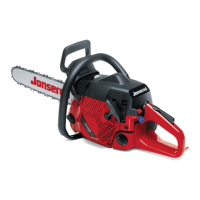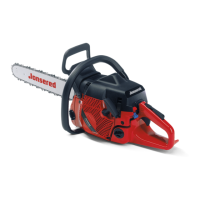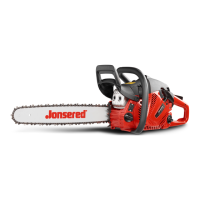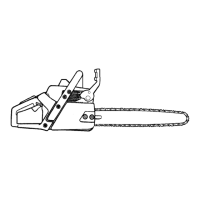English – 45
Repair instructions
Bolt the front vibration damping spring into posi-
tion, followed by both stops and the remaining
two vibration damping springs. Tighten to a torque
of 2–3 Nm. Check that both vibration damping
springs and the stops are correctly seated on the
crankcase. Incorrect fi tting may result in higher
vibration levels.
Connect pressure gauge 502 50 38-01 to the fuel
hose. Pump the pressure up to 50 kPa (0.5 bar).
The pressure should drop to 20 kPa (0.2 bar)
within 60 seconds.
2
Tank vent – testing
1
Use gauge 502 50 37-01 to measure vacuum.
Readings should be as follows: the vacuum should
increase from 30 to 15 within 30 seconds. If read-
ings are outside this range the vyon plugs must be
replaced.
Fuel tank – refi tting
1
Insert the fuel hose into the carburettor chamber.
Refi t the fuel tank.
2
Cleaning and inspection
Carefully check that:
• there are no leaks from the fuel tank
• there are no leaks from the tank fi ller cap
• the fuel hose is undamaged and free from wear
• the fuel fi lter is not clogged
• the tank vent is not blocked or leaking
• the vibration damping springs and stops are not
damaged
Replacing the fuel hose
1
Before replacing the fuel hose, measure the length
of hose between the crankcase and carburettor
and between the tank and crankcase. The cor-
rect hose length between the tank and crankcase
is 43 mm (1.69 inches). The correct hose length
between the crankcase and carburettor is 53 mm
(2.09 inches).
2
Remove the fuel hose from the fuel tank using tool
502 50 83-01. Trim off 5 mm (0.20 inches) from
the mitred end of the hose. Fit the fuel fi lter and
reinsert the hose in the tank.
NOTE!
Do not use knurled pliers to disconnect or
reconnect the fuel hose. This could dam-
age the hose.
Replacing the fuel fi lter
1
First remove the old fuel fi lter from the tank unit
using special tool 502 50 83-01.
2
Pull the fuel hose out of the tank and pull off the
fi lter.
3
Fit the new fuel fi lter and feed the fuel hose back
into position.
NOTE!
Do not use knurled pliers to disconnect
or reconnect the fuel hose. This could
damage the hose and lead to leakage or
fracture.
